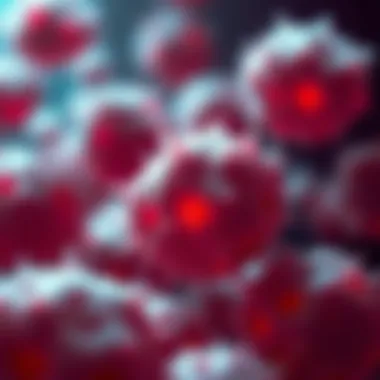Current Treatment Strategies for Chronic Lymphocytic Leukemia


Methodology
Study Design
To address the multifaceted treatment landscape of Chronic Lymphocytic Leukemia (CLL) as of 2021, a comprehensive mapping of current clinical practices was employed. The analysis drew from peer-reviewed articles, meta-analyses, and guidelines from leading oncological organizations to paint a holistic picture of therapeutic strategies. The intention was to provide an evidenced-based perspective that encompasses both traditional and innovative treatment modalities.
Data Collection Techniques
The data for this exploration was gathered through several channels:
- Literature Review: An extensive review of scholarly articles published up to 2021, ensuring the inclusion of cutting-edge therapy updates and historical perspectives. Academic databases such as PubMed (https://pubmed.ncbi.nlm.nih.gov/) and the American Society of Hematology (https://www.hematology.org/) were fundamental in accessing relevant studies.
- Clinical Trials: Ongoing trials, like those listed on ClinicalTrials.gov, facilitated an understanding of emerging therapies under investigation. This resource proved invaluable in identifying future treatment potentials for CLL.
- Expert Interviews: Engaging discussions with hematologists specialized in CLL treatment provided qualitative insights that augmented quantitative data. Their practical experiences shed light on therapy efficacies and patient responses, crucial for real-world applicability.
Together, these strategies ensured a well-rounded perspective on the state of CLL management, making it possible to assess the strengths and limitations of prevailing treatments.
Discussion
Interpretation of Results
The findings highlighted various effective treatment options for CLL, each coming with unique benefits and downsides. Traditional chemotherapy regimens such as fludarabine-based therapies have been pivotal in the past but are now often complemented or supplanted by targeted treatments such as ibrutinib or venetoclax. This shift reflects an evolving understanding of CLL's biology and its complex mechanisms.
Notably, the integration of monoclonal antibodies, such as obinutuzumab, with other therapies has been noted to improve patient outcomes significantly, illustrating the potential of combinational approaches. It becomes clear that, while there is no one-size-fits-all solution, a tailored therapy depending on individual patient profiles offers a new frontier in CLL treatment.
Limitations of the Study
Despite the thorough nature of our exploration, several limitations are notable:
- Variability in Clinical Practices: The practice of treating CLL can vary widely by region and institution, which can lead to inconsistencies in treatment experiences among patients.
- Limited Long-term Data: Many newer therapies, while promising, lack extensive long-term follow-up data, making it challenging to fully ascertain their sustainability and long-term safety.
- Bias in Available Literature: There is a tendency in published studies to highlight successful outcomes, which may omit cases with poor results, creating a skewed understanding of therapy effectiveness.
Future Research Directions
The shifting landscape of CLL treatment calls for ongoing research. Here are some proposed avenues for exploration:
- Longitudinal Studies: Long-term studies are needed to track the durability and safety of newer therapies as they become integral to treatment protocols.
- Comparative Effectiveness Research: More head-to-head studies between traditional chemotherapies and newer targeted agents would clarify efficacy and safety profiles.
- Genomic Studies: Understanding the genetic underpinnings that drive CLL could reveal insights into personalized medicine approaches, enhancing treatment precision for individual patients.
"As we navigate the complexities of CLL, the synthesis of ongoing research and clinical experience is crucial to optimizing patient care in this ever-evolving arena."
Intro to Chronic Lymphocytic Leukemia
Chronic lymphocytic leukemia (CLL) represents not just a medical challenge, but a complex landscape of treatment options that continue to evolve with ongoing research. In the context of this article, understanding CLL is crucial because of its significant impact on patient populations worldwide. This specific cancer type is driven by an increase in the number of B lymphocytes that are unable to properly mature, leading to complications in the immune system and various other bodily functions.
This section serves as a foundation for the rest of the article, shedding light on the disease's complexities, epidemiology, and the multifactorial nature of its risk factors. By delving into the aspects of CLL, we emphasize the urgency not just for effective treatment strategies but for a holistic understanding of the condition.
The exploration of treatment options like targeted therapies and immunotherapies requires an informed background. This primer helps lay the groundwork by discussing the disease's definition, epidemiological trends, and underlying risk factors that are crucial for patients, caregivers, and healthcare professionals alike.
Definition and Overview
Chronic lymphocytic leukemia can be succinctly defined as a type of cancer that primarily affects the blood and bone marrow, characterized by the accumulation of functionally impaired B lymphocytes. Often, patients may remain asymptomatic for years; the discovery is frequently incidental during routine blood tests. However, as the disease progresses, it can lead to various complications, including lymphadenopathy and splenomegaly.
The chronic nature of this disease differentiates it from acute forms of leukemia, where the onset is sudden and aggressive. CLL’s slow progression can obscure early detection, which commonly complicates treatment decisions.
> "Understanding the definition and progression of CLL is pivotal for tailoring effective treatment strategies that address individual patient needs."
Epidemiology and Risk Factors
The epidemiology of CLL indicates that it is one of the most prevalent leukemias affecting adults. Data suggest that the incidence rises with age, most notably affecting individuals over sixty, signifying a clear age-related trend. Environments, genetics, and immunity also play a role in its occurrence.
Key risk factors include:
- Age: The likelihood of developing CLL increases significantly as one ages.
- Family History: Genetic predisposition is evident, as those with relatives who have had CLL are at a higher risk.
- Exposure to Chemicals: Prolonged exposure to certain chemicals, including herbicides and pesticides, has been linked to increased risk.
- Ethnicity: CLL appears more frequently in Caucasian populations compared to African Americans.
Research continues to uncover factors influencing CLL's development and progression. Awareness of these risk factors helps guide discussions between patients and healthcare providers for better preventive measures and early diagnosis.
By capturing these fundamental elements of CLL, this section provides essential context that supports the forthcoming discussion on treatment modalities. Understanding the backdrop of this disease sets the stage for evaluating the advancements and options in the contemporary therapeutic landscape.
Pathophysiology of
Understanding the pathophysiology of chronic lymphocytic leukemia (CLL) is crucial for grasping how this disorder evolves and affects patients. The intricate genetic and cellular mechanisms at play offer insights into the disease’s behavior, guiding treatment options and management strategies. Thus, an in-depth exploration of these elements provides the foundation for effective therapeutic approaches and helps identify potential targets for intervention.
Genetic and Cellular Mechanisms


At the heart of CLL's pathophysiology are the genetic alterations that lead to the uncontrolled proliferation of malignant B lymphocytes. One notable characteristic of CLL is the accumulation of these cells, primarily due to their increased survival rather than rapid division. Key mutations associated with CLL include deletions in chromosome 13q, 11q, and 17p, as well as mutations in genes such as TP53 and NOTC.
These genetic markers not only serve as potential prognostic indicators but also inform treatment strategies. For instance, patients with 17p deletion generally have a poorer prognosis and may respond differently to conventional chemotherapy compared to those without this alteration.
- BCR signaling pathway: One major player in CLL pathogenesis is the B-cell receptor (BCR) signaling pathway. In normal B cells, this pathway is tightly regulated. However, in CLL cells, it’s often constitutively active, promoting survival and proliferation.
- Microenvironment interactions: Additionally, CLL cells interact with non-malignant cells in the bone marrow and lymph nodes that further support their survival. These interactions can activate signaling pathways contributing to a more favorable environment for cancer cells, such as through the secretion of cytokines and chemokines.
This evolving understanding of genetic and cellular mechanisms enables researchers and clinicians to devise new strategies for therapy, highlighting a trend towards more personalized treatment options tailored to specific genetic profiles.
Staging and Prognostic Factors
The classification of CLL is vital for determining the appropriate treatment regimen. Staging systems, primarily the Rai and Binet classifications, categorize CLL based on clinical features like lymphadenopathy, splenomegaly, and cytopenias.
Important prognostic factors include:
- Disease stage: Early-stage CLL (A/Binet stage) often has a more indolent course, while advanced-stage patients may experience rapid progression.
- Genetic markers: As mentioned, genetic abnormalities such as the presence of TP53 mutations or deletions significantly influence patient outcomes.
- Other clinical factors: Factors like patient age, performance status, and prior treatment history also hold weight in prognosis.
Understanding these classifications helps healthcare providers determine the most effective management approaches and tailor interventions for individual patient needs.
"The prognosis in CLL dramatically changes with each genetic and clinical factor considered, making a nuanced approach all the more essential in developing effective treatment plans."
In summary, the pathophysiology of CLL encompasses a complex interplay of genetic mutations and cellular mechanisms, alongside established staging systems that provide critical information for prognosis and management. As research advances, understanding these elements becomes ever more important in crafting innovative therapies.
Current Treatment Paradigms
Navigating the treatment landscape for Chronic Lymphocytic Leukemia (CLL) is no small feat, as the options available are vast and ever-evolving. Understanding the current treatment paradigms becomes paramount for healthcare professionals making clinical decisions, as well as for patients embarking on their treatment journey. The importance of this topic lies not just in the variety of medications and therapies but also in how they are integrated into patient management strategies.
This section outlines various approaches including conventional chemotherapy, targeted therapies, and immunotherapy, diving into each method's efficacy, associated benefits, and the considerations practitioners must weigh when determining the best course of action for individual patients.
Conventional Chemotherapy
For decades, conventional chemotherapy has stood as a cornerstone in CLL treatment. Drugs like fludarabine, cyclophosphamide, and rituximab have showcased their relevance by effectively targeting rapidly dividing cancer cells, albeit with a traditional approach. The fundamental idea behind this strategy is to interrupt the cellular reproduction cycle, thus aiming to reduce the overall leukemic cell burden.
While effective, it's crucial to acknowledge not only the successes but the limitations of chemotherapy. Side effects such as nausea, fatigue, and immunosuppression frequently accompany this treatment. Additionally, long-term use may lead to drug resistance, which can complicate or stall further treatment options. Nevertheless, for some patients, especially those with specific characteristics, conventional chemotherapy remains a viable or sometimes necessary option. In the chess game of CLL treatment, it may not always be the winning move, but it is often an opening strategy.
Targeted Therapies
Enter targeted therapies, a more precise approach that has gained traction in recent years. These drugs function by zeroing in on specific molecules involved in cancer cell growth and survival. For instance, ibrutinib and venetoclax have emerged as game changers, exhibiting remarkable efficacy in challenging cases. Their specialized action not only leads to reduced toxicity but also cultivates hope for better outcomes.
The wonderful thing about targeted therapies is that they tend to sidestep many of the systemic side effects associated with traditional chemotherapy. However, they come with their own set of challenges. Resistance can still develop, and some patients may experience adverse effects unique to these drugs, such as atrial fibrillation or tumor lysis syndrome. Thus, oncologists must remain diligent in monitoring patient responses and be prepared to adjust treatment protocols when necessary.
Immunotherapy Approaches
Then there's immunotherapy—a frontline innovation that taps into the body's immune system to fight cancer. By harnessing the power of immune cells, treatments like CAR T-cell therapies represent a revolutionary shift in CLL management. The thought process here is to train the immune system to recognize CLL cells as adversaries, ultimately leading to their destruction.
Though still largely in clinical evaluations and studies, early results show promising response rates. Nonetheless, not every patient is a candidate for immunotherapy, and its broader applicability remains an open question. Some difficulties patients confront include potential immunological side effects and the expense associated with such advanced treatments. Nevertheless, the emergence of immunotherapy marks a pivotal moment in the treatment landscape, reinforcing the idea that the fight against CLL is far from stagnant.
In summary, each treatment paradigm—conventional chemotherapy, targeted therapies, or immunotherapy—offers unique pathways with distinct pros and cons. Before determining the best approach, a multifaceted assessment considering genetics, disease stage, and patient preference is essential. The CLL treatment landscape is dynamic, continuously evolving with emerging research and clinical trials pushing the boundaries.
Endnotes:
- For further information about treatment options, the American Cancer Society has valuable resources on their website.
- Wikipedia provides a foundational overview of Chronic Lymphocytic Leukemia.
- For the latest research data and statistics, visit PubMed and explore current publications.
Emerging Therapies and Innovations
In the ever-evolving landscape of chronic lymphocytic leukemia (CLL) treatment, innovations spearhead the promise of more effective therapies. The emergence of new strategies is not just a hopeful prospect; it represents a crucial shift in how we approach this complex disease. This section shines a light on the significance of these advances, showcasing what they mean for patients and healthcare professionals alike. By exploring novel agents currently undergoing clinical trials and the concept of combination treatments, it becomes clear that the future of CLL management is on the brink of substantial enhancement.
Novel Agents in Clinical Trials
Clinical trials serve as the backbone for discovering innovative medications. These trials are lifelines that facilitate the testing of new therapies before they become widely available. In the context of CLL, several novel agents have shown promise in recent studies. Notable among these is Acalabrutinib, a Bruton's tyrosine kinase inhibitor that has been generating buzz for its potential in reducing the proliferation of malignant B cells while sparing normal lymphocytes. This specificity could translate to fewer side effects.
Another noteworthy agent is Venetoclax, which targets the BCL-2 protein. This mechanism blocks the tumor’s ability to evade apoptosis, or programmed cell death, presenting a compelling option for patients with relapsed or refractory CLL.
"Emerging therapies offer not just hope, but tangible improvements in CLL management that reflect a deeper understanding of the disease's biology."
Importantly, the role of biomarkers in these trials cannot be overstated. Biomarkers are crucial for determining which patients are most likely to respond to specific treatments, thereby making therapy more personalized and effective. Keeping an eye on these developments lets us grasp the potential reshaping of therapeutic paradigms in CLL.
Combination Treatments
Combination treatments harness the strengths of multiple agents to combat CLL more effectively. This strategy recognizes that a singular approach might not suffice given the complexity of the disease. For instance, combining Immunotherapy with Targeted Therapy has shown significant potential. This dual approach not only targets the cancer cells directly but also stimulates the body’s immune system to recognize and fight against the malignancy.


Several clinical studies have been investigating combinations like Obinutuzumab, a monoclonal antibody, with Venetoclax. This treatment duo has the potential to significantly improve outcomes, particularly in patients who have had limited responses to previous therapies.
Here are some reasons why combination treatments are gaining traction in CLL therapy:
- Synergistic effects: When two drugs work together, they can be more effective than the sum of their parts.
- Overcoming resistance: Using multiple agents can help to circumvent treatment resistance that often develops with monotherapies.
- Comprehensive action: A combination can confront the disease through different mechanisms, potentially leading to better eradication of malignant cells.
As we look towards the future of CLL treatment, combining these innovative strategies might be a foundational step towards improving the longevity and quality of life for patients.
Personalized Medicine in Treatment
Personalized medicine has emerged as a game-changer in the approach to treating chronic lymphocytic leukemia (CLL). This method tailors therapies based on the unique characteristics of each patient's disease and genetic makeup. The importance of this topic unfolds in multiple layers, as it highlights how adaptable treatment can dramatically improve patient outcomes.
Genetics play a pivotal role in determining how individuals respond to specific treatments in CLL. Understanding the molecular landscape of the cancer can provide insights into its behavior, allowing clinicians to predict which therapies will be most effective. Personalized medicine goes beyond conventional one-size-fits-all treatments; it emphasizes the necessity of understanding the patient's tumor genetics to devise effective strategies tailored to their individual profile.
Role of Genetic Profiling
A significant advancement in personalized medicine is genetic profiling. Genetic tests can identify mutations and abnormalities that characterize a patient’s CLL. For example, mutations in the TP53 gene are associated with a poorer prognosis and an increased likelihood of treatment resistance. By pinpointing these specific genetic anomalies, physicians can better understand which treatments might be ineffective or harmful.
Genetic profiling helps to understand the unique characteristics of each patient’s CLL, paving the way for more effective treatment strategies.
Moreover, other genetic markers, such as the presence of immunoglobulin heavy chain gene (IGHV) mutations, serve as important prognostic indicators. Patients with unmutated IGHV may respond differently to therapies compared to those with mutated IGHV. This information can be critical in deciding whether to pursue aggressive treatment or opt for a watchful waiting approach.
Tailoring Treatment Plans
The knowledge acquired from genetic profiling is instrumental in tailoring treatment plans. Instead of administering treatment based solely on the stage of cancer, clinicians can now consider the genetic makeup of the tumor. This customization may involve a combination of traditional therapies and novel agents that are more likely to yield positive outcomes based on an individual's genetic profile.
For instance, a patient with abnormal TP53 might be better suited for targeted therapies like ibrutinib or venetoclax, while those with favorable genetic profiles may withstand standard chemotherapy. This targeted approach not only improves the efficacy of treatments but also minimizes unnecessary side effects that could arise from administering more aggressive therapies to those who might not benefit from them.
The integration of personalized medicine into CLL treatment is a testament to the evolving landscape of oncology. As more data emerges and technologies advance, the potential for improved patient outcomes through tailored therapies will only grow. This shift in perspective underscores the crucial nature of continuous research and adaptation in clinical practice, as understanding the genetics of CLL could lead to more refined and effective therapeutic strategies in the future.
Treatment Outcomes and Quality of Life
In the context of chronic lymphocytic leukemia (CLL), understanding treatment outcomes and quality of life isn't just academic; it's foundational. When patients and clinicians engage in treatment planning, the goal is not only to extend life but to make sure that life is lived well. This holistic approach recognizes that the effectiveness of any treatment must be measured against its impact on daily living, emotional well-being, and long-term health.
Efficacy of Treatments
The efficacy of treatments for CLL is paramount. As new therapies emerge, evidence is mounting about which avenues yield the best results. For instance, studies have shown that targeted therapies, such as ibrutinib and venetoclax, often lead to higher response rates than traditional chemotherapy, which tends to be more toxic.
- Complete Response (CR) Rates: A good measure of treatment efficacy is observing CR rates. In recent analyses, some targeted therapies reported CR rates of approximately 80%, a steep climb compared to the 30-40% seen with older regimens.
- Time to Progression (TTP): This is another critical measurement. Most newer therapies have resulted in a significant delay in disease progression, allowing patients to enjoy extended periods of stability. If a patient can live years without their CLL advancing, that's a significant win.
However, it's not all about numbers. Success can also depend on patient-specific factors. Not every therapy will fit every patient as comfortably as a favorite pair of jeans. Genetic mutations, age, overall health, and previous treatments all play into how well a particular treatment will work for someone. Individualized assessments help in setting realistic expectations and fostering informed decisions.
Impact on Patient Quality of Life
As much as improving survival rates is essential, the conversation doesn't end there. The impact of treatments on a patient's quality of life can often determine the sustainability of a treatment regimen.
- Symptoms Management: Treatments like immunotherapy can sometimes trigger side effects like fatigue, nausea, or infections; these can negatively affect daily activities. Consequently, integrating symptom management into treatment plans not only enhances quality of life but also may result in better adherence to therapies.
- Psychological Well-Being: The mental strain of combatting a chronic illness can't be overemphasized. Psychological support, be it through counseling or support groups, can play a significant role in helping patients navigate their journey. Evidence shows that patients who engage with others and share their experiences tend to report better quality of life scores.
- Social Dynamics: Having CLL can affect relationships, both positively and negatively. While some individuals find strong support in loved ones, others may feel isolated. Ensuring that treatment plans consider social support networks helps foster holistic improvement in patients’ lives.
"The most important thing is to see the big picture – survival means nothing if one cannot enjoy life."
As we assess the landscape of CLL treatment, it's crucial that we not lose sight of the broader context. The goal should always be a balance between effective disease management and enhancing the patient’s overall experience of living with CLL. To remain engaged and proactive, patients should advocate for regular assessments of both treatment efficacy and quality of life, ensuring nothing falls through the cracks in their care.
Clinical Guidelines and Recommendations
The landscape of Chronic Lymphocytic Leukemia (CLL) treatment is ever-evolving, necessitating continuous updates in clinical guidelines and recommendations. These guidelines serve as a compass for healthcare providers navigating the complexities of this disease. They outline the best practices for diagnosis, treatment selection, and patient management, ensuring that patients receive care that is both evidence-based and tailored to their unique situations.
One of the heartbeats of effective treatment lies in the assessment of treatment approaches. This process entails evaluating every available treatment option, weighing its efficacy against potential side effects, and considering individual patient factors. Healthcare professionals must take an all-encompassing view—ranging from genetic markers to overall health—when determining the best course of action. For instance, while some patients might respond positively to conventional chemotherapies, others may achieve better outcomes through targeted therapies or immunotherapeutic regimens. A proper assessment ensures a more personalized treatment strategy, which is critical in the management of a heterogeneous disease like CLL.
In 2021, clinical guidelines recommended a multidisciplinary approach that combines efforts from hematologists, oncologists, and supportive care teams to enhance patient outcomes. It’s imperative to recognize that a one-size-fits-all model simply doesn’t apply in CLL treatment. The guidelines advocate for regular reevaluation of the treatment plan to adapt to any changes in the patient's condition or disease progression. Providing patients with a clear channel of communication about their treatment options empowers them to take an active role in their healthcare decisions. This notion of shared decision-making fosters trust, and it encourages adherence to recommended therapies, ultimately improving the prognosis.
"Informed patients follow their treatment plans better, which can significantly enhance their quality of life and treatment outcomes."
Assessment of Treatment Approaches
When assessing treatment approaches, key elements become evident. First and foremost, the effectiveness of a treatment option must align with clinical trial data and real-world outcomes. For instance, research indicates that Bruton's tyrosine kinase inhibitors, such as ibrutinib, have markedly improved outcomes for many CLL patients. Hence, such information becomes crucial in informing treatment decisions.
Moreover, risk stratification is a pivotal part of this assessment. Identifying high-risk patients allows for early intervention and potentially more aggressive treatment strategies. Features like genetic mutations or the presence of certain biomarkers can dictate treatment intensity, emphasizing the necessity for genomic profiling as part of the evaluation process. Additionally, understanding patients’ preferences, values, and even lifestyle can influence choices regarding treatment options.
Latest Protocols and Guidelines


The field of oncology is continuously shifting, with CLL treatment protocols updated regularly based on emerging evidence. As of 2021, the National Comprehensive Cancer Network (NCCN) guidelines highlighted some significant protocols that shape clinical decisions:
- First-line treatments often include targeted therapies such as ibrutinib or venetoclax, especially for those with certain genetic risks or comorbidities.
- Second-line options may be explored upon disease progression, with factors like previous treatment responses becoming significant.
- Monitoring strategies have also evolved, with guidelines suggesting more personalized follow-up schedules based on initial treatment responses.
Updated clinical guidelines also stress the importance of managing treatment-related adverse effects that may impact patients' quality of life. Regular assessment tools can help identify complications, allowing for timely interventions.
In summary, keeping abreast of the latest protocols and recommendations is vital for healthcare professionals managing CLL. These evolving standards hinge upon a wealth of research and clinical trials, ensuring that patients receive cutting-edge care tailored to their specific needs. Therefore, clinicians must stay informed about these changes to provide the best possible outcomes for their patients.
Challenges and Limitations in Treatment
Chronic lymphocytic leukemia (CLL) poses significant obstacles for both patients and healthcare providers. Understanding the challenges and limitations in CLL treatment is vital, as these factors influence not just clinical outcomes but also patient quality of life. The landscape of CLL therapy has changed dramatically in the past few years, yet hurdles still remain that can affect treatment efficacy.
One of the most pressing issues is treatment resistance. This phenomenon occurs when the cancer does not respond to a therapy that was once effective. Several factors contribute to treatment resistance in CLL; one important aspect is the genetic variability among patients. Each individual may harbor unique mutations within their cancer cells that render specific treatments less effective or even ineffective. Patients might start with a robust response to therapy, but over time, resistant clones can emerge, complicating the management of the disease. This leads to the necessity for continual monitoring and possibly switching therapies, an approach that can add an emotional and financial toll on patients and healthcare resources.
Treatment Resistance
Treatment resistance can manifest in multiple ways. Firstly, clonal evolution plays a crucial role. CLL is characterized by a diverse pool of cells, many of which can evolve and adapt in reaction to therapy. Some might flourish under selective pressures exerted by treatments, leading to a scenario where previously responsive cells are phased out in favor of resistant ones. The replacement of sensitive cells with resistant clones can make it challenging for healthcare providers to create long-term effective treatment plans. Additionally, specific gene mutations may lead to differing responses to targeted therapies, making it essential for clinicians to employ frequent genetic profiling in their patient management.
Another aspect related to treatment resistance is the role of the tumor microenvironment. The interaction between CLL cells and surrounding stroma can produce growth factors that shield malignant cells from apoptosis. These protective mechanisms can blunt the efficacy of treatments, further complicating therapy strategies.
Adverse Effects and Complications
While the struggle against treatment resistance is significant, adverse effects and complications from CLL therapies also cannot be overlooked. Treatment regimens can lead to a broad spectrum of side effects that range from mild to debilitating. For instance, many traditional chemotherapies have hematologic consequences, such as neutropenia, leading to increased susceptibility to infections. This is critical for CLL patients, as their immune systems are already compromised due to the leukemia.
Moreover, some newer therapies, particularly targeted treatments, may have unique side effects that can impact lifestyle significantly. For example, inhibitors like ibrutinib can lead to atrial fibrillation, hypertension, and other cardiovascular issues. These complications necessitate ongoing vigilance and may require the clinician to modify treatment plans, potentially delaying effective management of the disease.
The need for a multidisciplinary approach is underscored by the complexity of treatment-related adverse effects. Collaboration among oncologists, cardiologists, and primary care physicians is vital in order to ensure that the overall health of the patient is maintained while managing CLL.
In summary, with treatment resistance and adverse effects at the forefront, the journey of managing CLL remains fraught with challenges. This underscores the importance of continuously adapting therapeutic strategies and caring for the patients holistically, considering the intricate webs of challenges they face.
In tackling CLL, awareness of these pitfalls helps in formulating plans that are not only focused on survival but also on the quality of life for those affected. Understanding and addressing these challenges helps shape the future of treatment strategies, potentially providing better avenues for patient care.
Future Directions in Research
Chronic lymphocytic leukemia (CLL) research stands at the cusp of transformative changes. The ever-evolving landscape of therapeutic strategies is shaped by not only our deeper understanding of the disease itself but also advancements in technology and research methodologies. Exploring future directions in CLL research is crucial for several reasons, including potential innovations in treatment, improved patient outcomes, and the complexity of individual disease presentations.
“The future of CLL treatment hinges on our ability to adapt research findings into practical applications that cater to the unique needs of each patient.”
Innovative Therapeutic Approaches
In recent years, there has been a noticeable shift towards implementing innovative therapeutic approaches in managing CLL. These include not only refined versions of existing treatments but also entirely new classes of agents. One of the most promising avenues is related to the understanding of tumor microenvironments, which play a pivotal role in disease progression and treatment resistance.
- Targeted small molecules: These agents are designed to interfere with specific pathways critical to CLL cell survival. A recent focus has been on the B-cell receptor signaling pathway, where inhibitors like ibrutinib have already seen success. Research is pushing boundaries toward even more selective inhibitors that could lead to less toxicity and improved efficacy.
- Biologic therapies: Investigating therapies that leverage the immune system’s capabilities has gained traction. Chimeric antigen receptor (CAR) T-cell therapy has opened new doors and is in phases of clinical testing, aiming to enhance the body's immune response against CLL cells.
- Epigenetic modulators: These drugs target the epigenetics of cancer cells, aiming to reverse abnormal gene expression patterns. This approach holds promise as a supplementary treatment, possibly in combination with other modalities, to enhance response rates.
The aim of integrating these innovative therapeutics is to create a multifaceted treatment paradigm that caters to the unique needs of CLL patients, minimizing side effects while maximizing treatment outcomes.
Clinical Trial Opportunities
Clinical trials remain the backbone of progression in CLL treatment strategies. They present crucial opportunities to assess the effectiveness and safety of emerging therapies. Participation in well-designed trials not only provides patients with access to cutting-edge treatments but also contributes invaluable data for future research and understanding of the disease.
- Phased trial designs: Targeting specific subtypes of CLL through stratified trial designs can improve patient selection based on genetic and molecular profiling. This personalized method can lead to more precise treatment plans that are more likely to yield beneficial outcomes.
- Collaborative networks: Coordination between various institutions and centers allows for larger sample sizes and diverse patient demographics. Such collaboration enhances the reliability of results and can fast-track the approval of new treatments.
- Outcomes research: Emphasis on understanding patient outcomes, including quality of life indicators, becomes increasingly essential. Trials that consider these factors alongside typical clinical endpoints can provide a holistic view of a treatment's impact.
In summary, advancements in clinical trials are vital for evolving the landscape of CLL treatment. These trials not only allow for the rigorous testing of new drugs but also help in understanding the long-term effects of therapies, which is critical for shaping future treatment guidelines.
Research into the future directions in CLL is pivotal, not only for the ongoing fight against this disease but also for fostering hope and improved care strategies for patients. In a world where medicine is rapidly advancing, staying attuned to these developments ensures that the treatment of CLL can evolve, leading to enhanced outcomes and a better quality of life for those affected.
Closure
In the realm of Chronic Lymphocytic Leukemia (CLL), the journey of treatment options reflects both an evolution of understanding and the need for diligence in care strategies. Wrapping one's head around the complexities of CLL becomes crucial as we delve into the varied landscapes of therapeutics, from traditional chemotherapies to cutting-edge targeted approaches. The concluding segment of this article underscores key elements that are paramount to both patients and healthcare providers.
Summary of Key Findings
Throughout this exploration, significant findings emerge that illuminate the treatment options available for CLL.
- Traditional Chemotherapies: While these have been the standard for years, their effectiveness can be hindered by adverse effects and varying patient responses.
- Targeted Therapies: These have taken the forefront, offering mechanisms tailored to the unique aspects of CLL cells, often resulting in better outcomes in terms of efficacy and reduced toxicity.
- Immunotherapy Approaches: These strategies represent an innovative shift, utilizing the body’s defense system to combat CLL more prominently.
- Emerging Therapeutics: The landscape is opening up with novel agents that are currently in clinical trials, highlighting the importance of keeping an eye on ongoing research and advancements.
This synthesis of treatment methodologies shows not only the breadth of options but also the nuanced considerations that must be made based on individual patient metrics.
Implications for Future Treatment Strategies
Moving forward, the implications of these findings are manifold. Adaptation to emerging therapies is critical. Some focal points to consider include:
- Personalized Medicine: As treatments become more focused, aligning therapy with genetic profiling will likely yield better management strategies.
- Incorporation of Innovations: New findings from clinical trials should inform treatment protocols, encouraging oncologists to remain flexible in their approaches.
- Patient-Centric Care: Understanding the quality of life impacts is essential. Treatments that strain a patient's wellbeing can often outweigh their benefits, necessitating a careful balance.
- Continued Research: Ongoing investigation into drug resistance and treatment complications must inform both future strategies and clinical guidelines.
In summary, the treatment of CLL is not a one-size-fits-all scenario. This discussion not only emphasizes the current choices available but also lays the groundwork for what lies ahead, ensuring that advancements continue to align with patient-centered care. For further reading and resources, the following links could provide additional insights:







